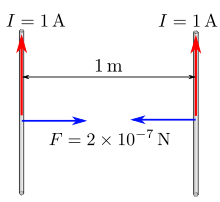ampere
The ampere (symbol A) is the SI unit for electric current and is one of the seven base SI units. It was named after André-Marie Ampèr (1775 - 1836), a French mathematician and physicist who we consider the father of electrodynamics.
The ampere is used to express the flow of electric charge. 1 amp is equal to the transfer of 1 coulomb in 1 second.
Ampere should not be confused with Coulomb (ampere-second). Ampere is a unit of electric current flow, i.e. the amount of passing charge per unit of time, coulomb is a unit of electric charge.
Definition

Illustration of the definition of an ampere
Ampere's force law states that there is an attractive or repulsive force between two current-carrying conductors. This force is used in the formal definition of the ampere: The ampere is a constant electric current which, when passing through two straight, parallel, infinitely long conductors of negligible circular cross-section placed in a vacuum at a distance of 1 meter from each other, produces between them a constant force of 2×10−7 newtons per 1 meter of length the driver.
The SI unit for charge, the coulomb, is the amount of charge transferred by a current of 1 A in 1 s. Conversely, a current of 1 A represents the flow of a charge of 1 C through a given point in a conductor in 1 s.
History
The ampere was originally defined as a tenth of a unit of electric current in the CGS system. That unit is now called the ampere and was defined as the amount of current which, when passing 1 cm of conductors 1 cm apart, produces a force of 2 dynes.
The international ampere was the forerunner of the ampere; has been defined as the current which expels 0.001 118,000 grams of silver per second from a solution of silver nitrate. Later measurements determined this current to be 0.995 85 A.
Proposed future definition
As a more appropriate definition, the definition of the ampere using the flow of elementary charge has been proposed. Since a coulomb is equal to approximately 6.2415093×1018 elementary charges (such as electrons), one ampere is equal to the passage of 6.2415093×1018 elementary charges through a point on a conductor in 1 second. The proposed change would define 1 A as the current in the direction of flow of a given number of elementary charges per second.
